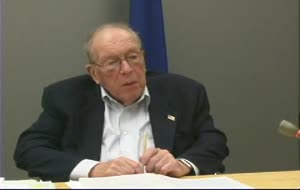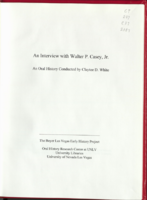Search the Special Collections and Archives Portal
Search Results
Audio recording clip of interview with Vernon Jones by Mary Palevsky, October 4, 2005
Date
Archival Collection
Description
Sound
Audio recording clip of interview with Richard Wyman by Suzanne Becker, July 7, 2005
Date
Archival Collection
Description
Sound
Audio recording clip of interview with Richard Wyman by Suzanne Becker, December 1, 2005
Date
Archival Collection
Description
Sound

Video clip of interview with Laurie Joe (L. Joe) Deal, September 27, 2005
Date
Archival Collection
Description
Moving Image
"Beckmann interviews, studio footage, self-shot" miniDV tapes, approximately 2000 to 2005
Level of Description
Archival Collection
Collection Name: Robert Beckmann Professional Papers
Box/Folder: Box 17
Archival Component

Transcript of interview with Stella Butterfield by Joanne Goodwin, October 14 & October 25, 2005
Date
Archival Collection
Description
Interviewed by Joanne L. Goodwin. Stella Butterfield's family, the Goldbergs, was Jewish, and she was born in the Bronx. During World War II she worked for the Coast Guard in the steno pool in Washington, D.C. Stella moved to Santa Monica a few years later while the war was still going on and worked briefly as a riveter for Douglas Aircraft and then as a teletype operator for the Air Force but at Douglas Aircraft. Because she had a hard time getting a job because of antisemitism, she changed her name to Gilbert. In December of 1948 she went to the Canal Zone in Panama to be the secretary of the commanding officer of the Panama Supply Depot. Stella was also a law reporter for court martials. She met Frank Butterfield, who was stationed there, and married him in 1952. He was transferred back to the United States, and they lived in Massachusetts. Then they moved to Los Angeles, and in 1953 they moved to Las Vegas, where she was a court reporter at Nellis Air Force Base. Then they moved to Mexico City, then back to California where she worked as a legal secretary. In early 1955 they moved back to Las Vegas, and Stella worked as a federal court reporter for Judge Roger T. Foley.
Text
Mary Ann Michel oral history interview (OH-02504), 2005 March 16
Level of Description
Archival Collection
Collection Name: History of Nursing in Southern Nevada Oral History Project Records
Box/Folder: Digital File 00
Archival Component

Transcript of interview with Walter P. Casey, Jr. by Claytee D. White, November 15, 2004 and January 13, 2005
Date
Archival Collection
Description
Text
Audio recording clip of interview with John Hopkins by Mary Palevsky, April 11, 2005
Date
Archival Collection
Description
Sound
Audio recording clip of interview with David B. Thomson by Mary Palevsky, April 12, 2005
Date
Archival Collection
Description
Sound
